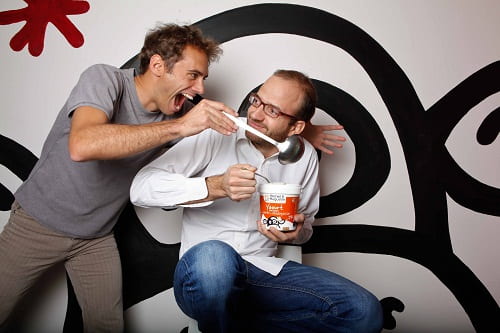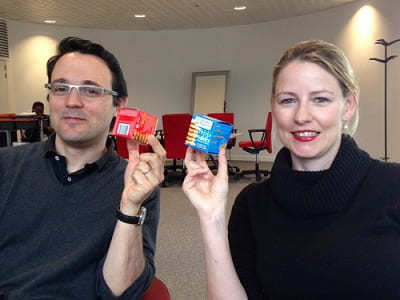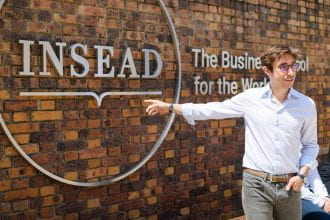An award-winning INSEAD case shows how Michel de Rovira MBA’04D turned a tasty idea into a profitable business.

The odds were against the two guys in a Paris kitchen, baking cookies and cooking up an entrepreneurial dream.
It’s 2005 and childhood friends Michel de Rovira MBA’04D and Augustin Paluel-Marmont are taking the first steps to turn their love of French pastries into a viable business venture—one that can compete in a vicious (if delectable) market against much larger rivals like Kraft Foods and United Biscuits. To make matters more challenging, they have very limited capital.
They do have a business foundation. Michel studied finance at ESCP Europe and was a former L.E.K. consultant; now, he was starting his INSEAD MBA. Augustin holds an EAP business degree and has a knack for marketing. But, overall, the balance sheet reflects less-tangible assets: their passion, culinary expertise and offbeat personalities that might help distinguish them in a crowded global arena.
Soon, in a push to scale up, they rent space one day a week in an industrial bakery. They buy a €5,000 custom mould that, much to their dismay and despite their best efforts, produces only broken cookies. They keep trying in the face of David-versus-Goliath odds. The product line gradually expands from the initial sablé, a shortbread biscuit, to a dozen snack offerings.
The young entrepreneurs learn that a slim marketing budget can be supplemented by unorthodox publicity stunts, including one featuring Microsoft founder Bill Gates at a 2007 Entrepreneurs Congress in Paris. There, they manage to impersonate caterers and smuggle a few boxes of their “vache à boire”, or “drinkable cow” line of yogurt into the event. One of the beverages ends up on camera in front of Gates himself. More quirky, but effective, guerrilla marketing efforts follow, including ones with the founders dressed as cows.
If all this creativity and persistence is the stuff of entrepreneurial dreams, it’s also the perfect material for a business school case study, which is exactly why INSEAD Marketing Professors Hernan Bruno and Hilke Plassmann wrote one about Michel et Augustin, the eponymous startup that has grown from two employees to some 70 over the last eight years. In fact, the case recently won the “Best New Writer” award in the 2014 Case Centre global competition that annually honours the world’s top case teaching and research.
“It was gratifying to create a case about a dynamic company launched by an INSEAD alumnus,” says Professor Plassmann, who admires the innovation of the co-founders. “The case offers great learning from a marketing standpoint because the company’s success really depended on its ability to build a strong brand around a unique story, and do it in a fun way that connects with customers.”
Professor Bruno agrees, saying that the company has maverick qualities that let it stand apart from the herd.
“The company is authentic, truthful and transparent—and a bit irreverent. They care about the quality of the products and they obsess about taste, but it was clear that they also really focused on the brand rather than just the product,” says Bruno. “When we learned the venture was built by two guys with no resources, we knew we had a story that managers could learn from and two ‘heroes’ that everyone could empathise with.”
While their personas may seem unorthodox—even wacky—Michel and Augustin have done their due diligence. In 2003, the pair travelled throughout Paris, visiting more than 1,200 bakeries and sampling nearly 2000 products as research for their Guidebook of Parisien Bakeries, published in 2004. Michel has a natural affinity for such scrupulous research, and so found the opportunity to work with INSEAD faculty on the case both intellectually and commercially rewarding.
“I loved case studies as a student,” says Michel, “so I was very excited to share a lot with Hilke and Hernan about the issues we faced trying to create a new brand in a crowded market.” He adds that his firm’s story is one of “trying to find the ‘blue ocean’ amidst the ‘red seas”—a reference to the Blue Ocean Strategy framework of INSEAD professors Chan Kim and Renée Mauborgne.
The challenges were formidable from the start, as the case study makes clear.
In France, a few global players have dominated cookie sales, competing for retail shelf space and customer attention. Kraft Foods, operating under the LU label, produced its Petit Écolier, Mikado and PiM brands and was the clear market leader with 41% of total cookie sales in France in 2008. Additional competition came from the increase in supermarket private labels brands. Changing consumer habits resulted in further complexity and pressured companies to keep introducing new products in an effort to maintain customer interest. Often, these were not true innovations, but simple variations on an existing theme. Still, even lacklustre product extensions benefited from major advertising campaigns that could run to €10 million—a figure well out of range for a fledgling market newcomer.

Against this backdrop, Plassmann and Bruno’s case highlights key strategic questions: How should the firm position its brand in this competitive landscape? What products should they focus on and what distributions channels should they leverage? How should they market the company despite having only a modest advertising budget?
“Michel and Augustin were well aware that a unique brand positioning was the key that could mean the difference between being a success and just another failed business venture,” the INSEAD faculty members write.
Michel says that collaborating with Plassmann and Bruno was a “great way for us to gain further insights on branding to step back and think about our strategy in fresh ways,” including international distribution of products.
For the marketing professors, the case offered a new channel to enhance their research and teaching by integrating novel practitioner insights. “Michel and Augustin have been masters of PR,” says Bruno. “The number of press appearances is enormous for a company of that size.” In writing the case, their main challenge was finding the right focus by streamlining some of the real-world complexity while retaining some of the valuable richness.
The award-winning results, say the co-authors, were inspired by the outstanding work of their INSEAD colleague Pierre Chandon, The L’Oréal Chaired Professor of Marketing. “He has written several winning cases, and they were a good model for us,” says Bruno.
While the Michel et Augustin case was the first for the faculty colleagues, its success will encourage Plassmann and Bruno to develop additional ones, they say, opening the doors for potential further collaboration with alumni.
“Our MBA students love this case because they can really relate to Michel,” says Plassmann. “Most of them are torn between becoming an entrepreneur or taking an offer from a major consultancy. I think our case illustrates some of the challenges, courage and creativity involved in making your business dream a successful reality.”


